Author: Adam Bunker
Subject Matter Expert: Dave Pabley
What is customer service experience?
Customer service experience describes the cumulative way people feel after having interacted with your business – across each and every touchpoint. That includes direct and indirect support communication, as well as how streamlined the overall customer journey was on the way toward making a purchase.
If a customer has needed to reach out for help, for example – either on the phone, via instant message/live chat, email, text, chatbot, in person, or on social media – then they’ve experienced what your customer service offering provides and will have formed an opinion of it.
But customer service experience also consists of indirect interactions – and is informed by how you respond to them. For example, if a customer writes a post on Reddit bemoaning the quality of your product, then you can use that as a way to open a dialogue and get their issue resolved. In that case, you’ll have turned that interaction into a positive piece of customer service – and the customer will feel as though they’ve had a more positive overall customer service experience.
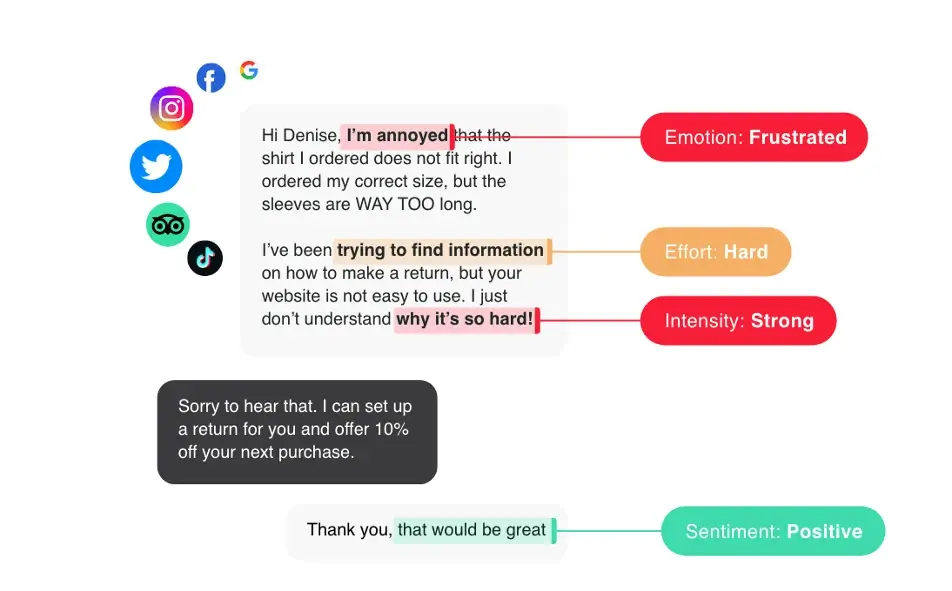
Customer service experience extends beyond just the traditional back and forth of customer support; the sales and purchasing experience counts just as much. In other words? If the process of actually making their way from awareness through to purchase is smooth, that too becomes part of your overall customer service experience.
Because customer service experience spans both the pre and post-sale journey, it’s a hugely important thing to focus on improving. After all, if customers enjoy a positive experience, you’ll earn their loyalty, repeat purchases, and the chance that they’ll influence their peers.
Free eBook: Making the business case for contact center transformation
Why is customer service experience so important?
Customer experience (CX) is currently the most crucial battleground for modern businesses. It’s where lifelong customers are won or lost, and it’s where reputations can be set in stone or spiral out of control. As a subset of CX as a whole, ‘customer service experience’ is no different – people remember good and bad experiences alike, and they share both with the people around them.
That’s why businesses globally are putting more and more time, money and resources into shaping their customer experience offering.
Zendesk, for example, reports that 80% of business leaders are on track to up their customer service budgets over the coming years, while the XM Institute estimates that those who do will contribute to some $700 in additional CX investment.
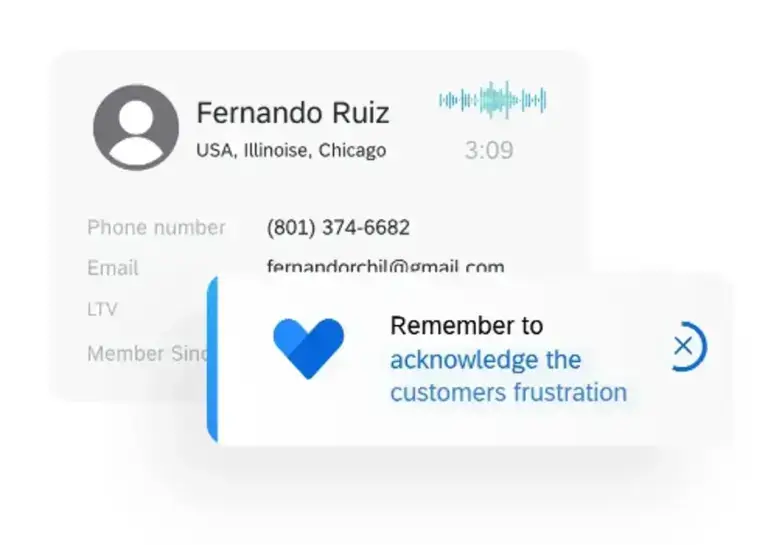
And that’s with good reason: companies that focus on customer experience report up to an 80% increase in revenue. Often that’s driven by customer spending habits. For example, PWC cites that 86% of consumers are willing to spend more for excellent customer experience, while Forrester suggests that customers who have their issues solved quickly are 2.4 times more likely to stick with a brand.
But the opposite is also true: whenever companies fail to invest in their customer service experience, they run the risk of hemorrhaging otherwise loyal customers. Hyken research shows that up to 90% of customers will switch to competing companies for better CX.
That risk even applies to your most loyal customers. Emplifi reports that 49% of customers who do leave a brand that they’d previously been loyal to do so due to poor customer experience. Our own research, meanwhile, shows that only 13% of consumers will recommend a company whose customer service they’ve rated as “very poor.”
The message is clear: consumers expect stellar customer support that goes above and beyond – and which forms part of an excellent overarching customer experience. The onus is on brands to deliver, or risk losing customers to the ones that do.
What are the qualities of great customer service experience?
So what does a great customer service experience look like? In simple terms, it means understanding people, empathizing with what they need, and delivering it quickly.
That means getting the human elements of compassion, attention, understanding, and proactivity bang on – caring deeply about customers is what sits right at the heart of outstanding customer service experience. Here are a few core tenets to focus on:
- A friendly attitude
Customers want to feel welcomed and valued, so greet them with a smile and pleasant demeanor, whether you’re speaking to them in person or otherwise. - Active listening
Give customers your full attention; really listen to and understand their needs before responding. - Clear communication
Use positive, easily understood language to manage expectations and explain solutions. - Knowledgeable support
Have the expertise and resources to answer questions and resolve issues accurately. - Quick response times
Reply to inquiries promptly. No customer should be left a long time waiting for assistance. - Personalized care
Treat each customer uniquely based on their specific needs, issues, and history with your company. - Agent empowerment
Employees should be equipped with the right tools to help them make decisions that delight customers. - Follow-up
Check in with customers further down the line to ensure issues are fully resolved and needs were met. - Appreciation
Express genuine gratitude for customer loyalty to help foster it – make sure you do what you can to help customers feel valued. - Accountability
Take ownership of any mistakes and work to immediately correct them for customers and for others going forwards.
How do you build a great customer service experience?
Customers remember service experiences that feel seamless, connected, personalized and empathetic. Creating a reputation for customer service experience that ticks all those boxes isn’t easy, but it can be managed by following a four-part strategy:
1. Use AI to supplement human empathy
2. Ensure agents are firing on all cylinders
3. Understand and fix pain points before they arise
4. Think about the entire journey
1. Use AI to supplement human empathy
Great human customer support agents are naturally inclined to want to help customers as best they can, but there are a bunch of ways in which modern AI tools can help supercharge their abilities.
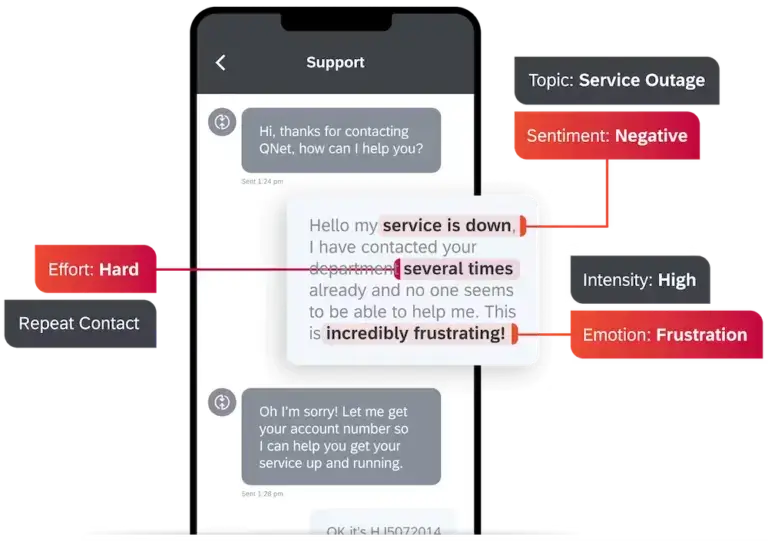
Say, for example, that you have a contact center management tool that can listen in on calls, understand IMs, and scour emails for values like sentiment, effort and intent. With this information, alongside instant access to each customer’s history, agents can receive live prompts that help them show greater empathy, understanding, and issue resolution superpowers. That might be as simple as an acknowledgment that a customer has faced this issue before, or as intuitive as a bespoke discount offer based on their unique preferences.
AI can also help free up agents to take on more support queries by automating some of the more time-consuming post-interaction tasks, like after-call writeups. If you have a contact center management tool imbued with AI and natural language processing, you’ll benefit from automatic write ups that understand everything that happened and know exactly what the next steps should be – letting your human agents do what they do best: handle more customer support issues.
2. Ensure agents are firing on all cylinders
You’re already hiring customer support staff with soft skills like patience, communication, and de-escalation, but how do you know if that’s transferring to real-world performance? Sampling customer interactions will always be an inefficient way to figure out who’s performing to the best of their abilities, and who needs a helping hand.

Again, AI in the contact center can help here. With the ability to listen in or read along with every interaction, natural language processing tools can help identify coaching opportunities for agents that need it, as well as provide insights based on common metrics like script compliance alongside more commonly ‘unstructured’ data like empathy.
Great customer service experience is built by human agents who are working at the top of their game, so it pays to have a formalized process and structure in place for monitoring, training and improvement.
3. Understand and fix pain points before they arise
Your customer service team has an important job beyond just fixing customers’ immediate issues. As an insights goldmine, the team also has a responsibility to spot trends and emerging product or service issues, and forward them to the people who can get them fixed before they have a chance to escalate into reputational damage.
The contact center is the first port of call for customer issues, so it’s where information about pain points and experience gaps should come from. But to make use of all that invaluable information, you’ll need to have tools in place that can connect the dots. Individual agents might not be able to spot emerging trends, but software that spans the entire contact center can.
Imagine, for example, that a number of customers speak to different agents – on different touch points – about an issue with moving through the checkout process on your website. AI-powered contact center technology would be able to do what those individual agents couldn’t: join things together and flag that these aren’t isolated incidents – and that the website’s UI or development team need to step in to fix that issue before more customers run into it.
4. Think about the entire journey
Every step of the customer journey helps define the overall customer service experience, so it’s important to think about those journeys as end-to-end processes, rather than a series of one-off incidents.
Customer journey mapping can help you understand how touchpoints are connected, and how keeping loyal customers is often managed through the same steps that attract new ones. Using the right customer experience management tools will provide you with behavioral data, which you can comprehensively map the complete end-to-end customer experience – highlighting all the key steps customers go through across channels like website, app, phone, and in-store.
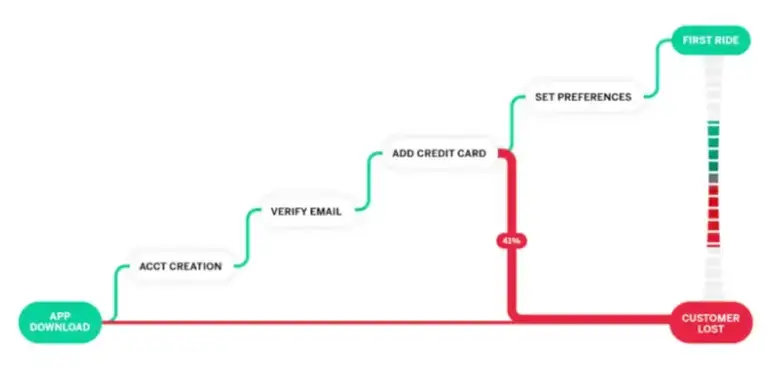
You can then use this map to identify inconsistencies, gaps, pain points and – crucially – any opportunities to connect journeys across teams like sales, billing, and custom service. That means unified messaging, branding and hand-offs between departments, and it means thinking about the customer journey as a cycle.
The best way to achieve excellence is to invest in both digital capabilities and human interactions. When you optimize the entire journey and have every part helping to build the others, you’ll have a recipe for an exceptional customer service experience.
Customer service experience: Digital vs physical
Customer service experience is borderless and spans across touchpoints. That also means that building a great customer experience happens in person and across all your digital channels.
Customer service experience in digital
In digital, it’s vital that you think beyond just the contact center. You’ll want to use tools that can map real customer behavior to your digital channels in order to highlight areas for opportunity. If you can spot where along the journey you’re losing customers – for instance on a specific part of your website – you’ll know that there are UI or content issues that can be fine-tuned to maximize those conversions.
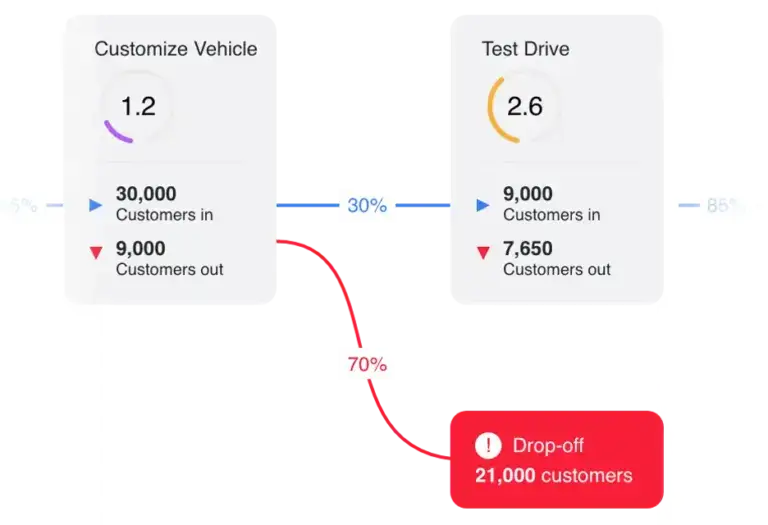
Fix those issues, and you’ll see your cumulative customer service experience improve.
Using tools like session replay and customer journey optimizer can help you understand where frustration happens and work to fix it – that way you’ll ensure more customers make it through to purchase (and beyond) feeling happy with every step of the experience.
Customer service experience for location-based businesses
Ok, so what about in face-to-face, brick-and-mortar locations? The customer service experience is just as important here, and luckily there are a wealth of tools out there to help you ensure that things run smoothly.
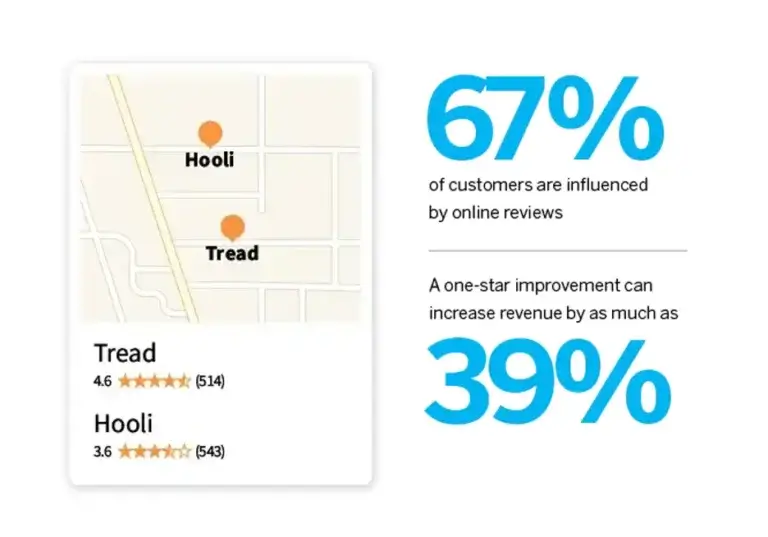
For starters, you can use AI-powered listening tools to automatically scour the web for location-specific insights. People are often reluctant to provide feedback in person, but their online reviews and social posts can tell you a lot about what is and isn’t working when it comes to customer service. Using tools that can read and interpret these for you at scale will help flag issues early.
When you act on that information, through staff training programs, unique discounts, or direct responses online, you’ll turn negative feedback into customer loyalty – and build a reputation for excellent in-person customer service at the same time.
Free eBook: Making the business case for contact center transformation